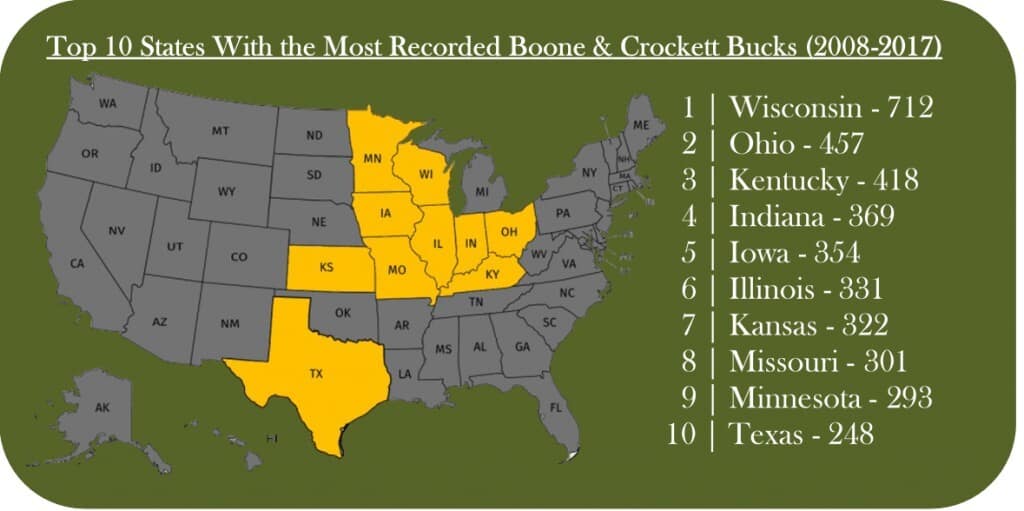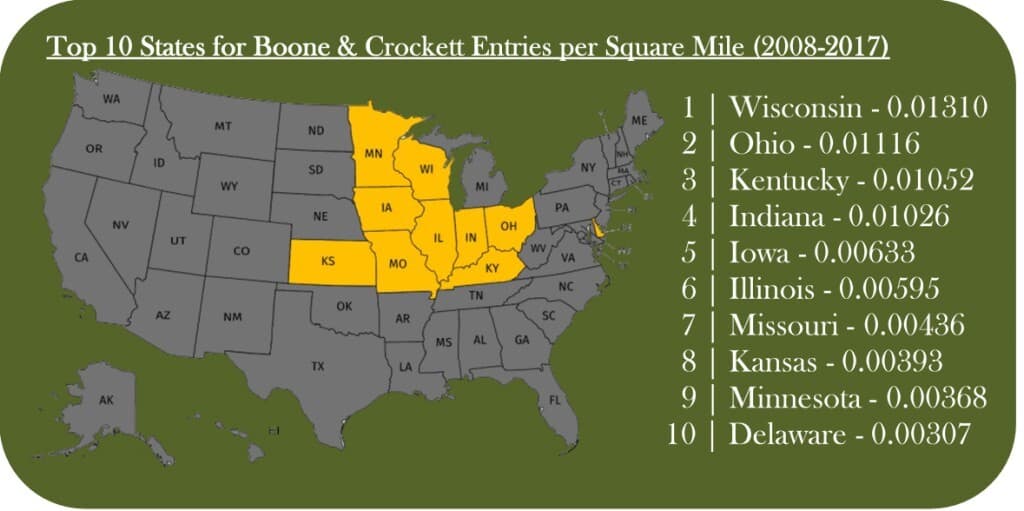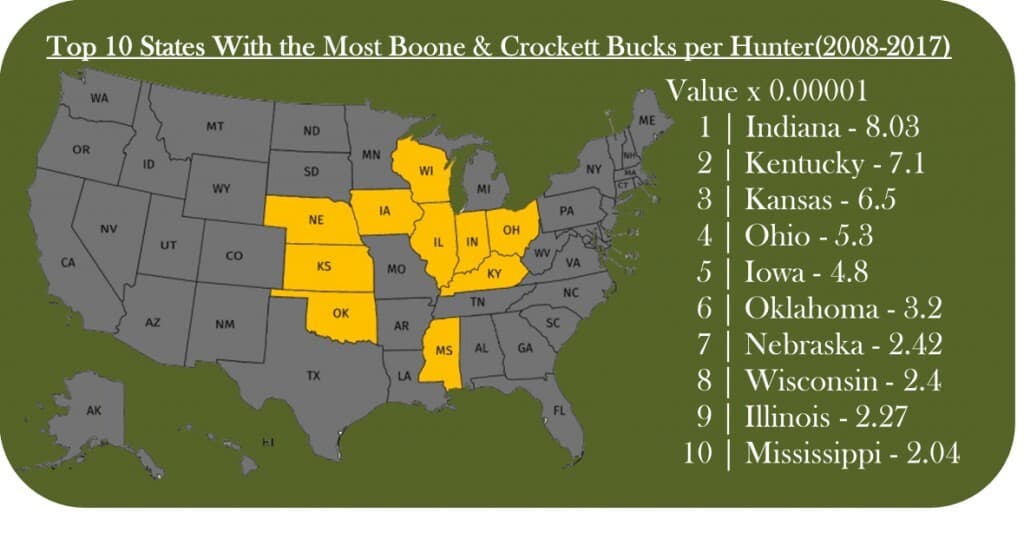Most of us choose to hunt whitetails in our home state, but where are the biggest whitetail deer? If you just travel one or two states away you will see a definite difference in the deer population. On average, they may be bigger-bodied and have bigger antlers, or they could be much smaller. With a little research, you can find the perfect place to harvest much bigger bucks with the same amount of effort. Like my dad always says, “to shoot big deer, you have to go where the big deer are”.
General Rule of Thumb | Bergmann’s Rule
Bergmann’s rule states that specimens of the same species will differ in size dependent upon the climate they live in. Specimens that live farther away from the equator (colder climates) will grow to be bigger than specimens of the same species that live closer to the equator (hotter climates). Although this only holds true 100% of the time for large mammals (including humans) and birds because these animals are endotherms.
This is why on average we see the biggest whitetail deer come from the northern states. It does not mean that Florida bucks cannot grow to be a considerable size. However, the climate and resources make it much more challenging to do so.
Although we do see some states that challenge this rule recently; however, this is due to successful whitetail and habitat management. Left alone, whitetail would follow this rule 100% of the time, but as it is now, they follow this rule most of the time.
So Where Are the Biggest Whitetail Deer?
There are a few different ways we can compile whitetail harvest data to answer this question. The best in my opinion would be to take the average of the scores for bucks harvested in each state. However, seeing as it is not a requirement to report the score of a buck you harvested, that is impossible. So to find out where the biggest whitetail deer are, we will break down the data in a few different ways.
How We Will Break Down the Data
There are a number of ways for us to analyze the data. Here is a quick look at how I will break it down:
- First, we could look at which states have recorded the biggest whitetail deer. This is a quick glance at where the giants are. However, it is not a fair representation of where the most Boone & Crockett bucks are harvested.
- Secondly, we will look at how many Boone & Crockett bucks total have been harvested from a state. This is a great way to analyze the data but with recent developments in habitat management, it could be unfair to up and coming states.
- To combat this, we will also look at the total number of Boone & Crockett bucks harvested over the 2008 to 2017 decade. This will show which states are producing the most Boone & Crockett bucks now and will not be swayed by bucks produced 80 years ago.
- We run into another problem due to the fact that some states are larger than others. So we will also look at how many Boone & Crockett bucks were harvested during the 2008 to 2017 decade relative to that state’s landmass.
- Lastly, we will analyze how many Boone & Crockett bucks have been harvested during the 2008 to 2017 decade relative to the number of hunters that purchased licenses for that year.
What It Takes to Be a Boonie
To make it into the Boone & Crockett record books, typical bucks must score at least 170 inches, and non-typical bucks must score 195 inches or more. Since typical bucks and non-typical bucks have different requirements, in the all-time record section I will separate them. I also limited each state with only one spot on this list. So if the state had two all-time records, I chose the biggest one.
I will be excluding Canadian provinces for the sake of ranking American states
States With the Largest Record Boone & Crockett Bucks
Data from Outdoorlife.com
You can see here that the biggest typical whitetail deer were taken in the midwest of the United States. With a couple of them budding up to large Canadian populations. Now let’s check out the non-typicals.
As you can see from the maps, these are the same general areas in the midwest United States. Although just looking at all-time records alone is not really a fair representation of the data. Instead, we can look at the sum of Boone & Crockett bucks that have ever been recorded. This should show us the states with the highest probability of producing a Boone & Crockett buck.
States With the Most Recorded Boone & Crockett Bucks
Data from Realtree.com
Again this is showing us the same general midwest area, but there are better ways to look at this data. During recent decades, whitetail and habitat management have become much more popular and successful. Leading to the production of bigger whitetail deer overall. We are now able to perform all sorts of experiments and see exactly how we can help whitetail populations become healthier and grow bigger racks.
So with that being said, how would the data look if we looked at the total number of recorded Boone & Crockett bucks over a recent decade? The data I found covers the 2008 to 2017 seasons.
Accounting for Better Management Strategies in Recent Decades

This data gives us a really good indication of where the best management practices are taking place. We can see that our trend is still in the midwest. It is actually the same list of states but in different ranking order.
Although to effectively analyze this data it has to be “normalized”. Simply, we need to compare the data from different states on the same scale. One scale that we have ignored up until this point is landmass.
Accounting for Differences in Landmass
Since some states are bigger than others, technically a state like Texas (268,597 square miles) has a much higher chance of producing a Boone & Crockett buck as opposed to a state like Delaware (2,489 square miles). So in this portion of the analysis, we will look at the number of recorded Boone & Crockett bucks for a state in recent years (2008 – 2017), divided by its size.

So this does change our list slightly, but not very much. As I foreshadowed before, looking at the data this way takes away Texas’s size advantage and lets Delaware shine in the 10th spot. It is important to normalize the data in this way so you can see how “efficient” the land is. Just because more Boone & Crockett bucks come out of one state rather than another, does not mean that it is better than the other in terms of your probability of running into a Boonie there. To help us calculate that probability we need to know how many hunters there are.
Accounting for the Number of Hunters per State
Although there is one more factor that we have not discussed. If you are out looking for something in a huge field, would you be more likely to find it by yourself or with a group of people? Well, we can think of deer hunting the same way. If there are more hunters out in the woods in a particular state, then their chances of running into a Boone & Crockett buck should increase. Assuming that there are deer of that class in the area.
For example, if a state produces 100 boonies but has a million hunters, you would be better off hunting in a state that has 50 boonies with 100 thousand hunters.
So I filtered through 10 years of data to find out how many licenses were sold and compared that to how many Boone & Crockett bucks were harvested during that same time. This should tell us how many hunters there were. The only calculation I did here simply took the number of record bucks over this 10 year period and divided it by the sum of total licenses sold during that same time.
This is your percent chance of running into a Boone & Crockett class buck at random from these states. Obviously, if you are hunting a well-managed property, you will be growing bigger deer than most of the state. In that case, these numbers do not really apply to your chances. They would be much higher. The data only shows total harvests over this period and not how many were harvested from managed or unmanaged lands.
What Does the Data Say?

Just because a state has a high probability of producing a Boone & Crockett buck, does not mean that you will be the one to shoot it. Some states have some fierce competition. In Indiana (your best chance), any given hunter has a 0.0000803% chance at harvesting a Boone & Crockett buck. That sounds pretty impossible. You have about the same chance of getting struck by lightning. About 0.00006% on any given day (that is just a 0.00002% difference!).
However, with around six million whitetails being harvested from the United States every year, according to these numbers, there are around 300-500 Boone & Crockett bucks killed per year. That may not sound like a lot, but the requirements to make it into the Boone & Crockett class are steep. Where there are Boone & Crockett deer being taken, there are sure to be 120 to 160-inch trophies as well.
Conclusion
To kill the biggest whitetail deer, you have to go where the biggest whitetail deer are. After looking at the data, it seems as though most of the big deer are in the midwest. Many states from the midwest are repeat contenders on our lists we had above. So you really cannot go wrong with hunting in Iowa, Illinois, Indiana, Ohio, Kentucky, or the state that was constantly at the top of our lists, Wisconson. While it is great to look at the data and try to find the absolute best spot, the only way to harvest a Boone & Crockett buck yourself is to get out there after them wherever and whenever you can.
Thank you for reading my article about where the biggest whitetail deer are. I hope you enjoyed it and learned something you didn’t already know. If you like my content, subscribe to my weekly update. If you have any other questions about where the biggest whitetail are or just want to connect, feel free to email me at [email protected].

